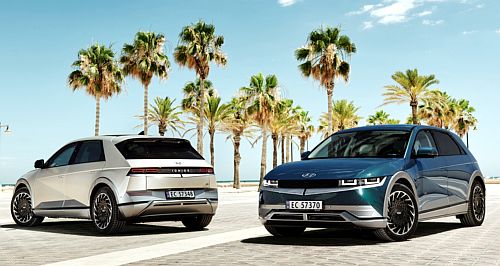News - HyundaiHyundai supply easingMore Hyundai models becoming more readily available as kinks in supply chain reduce4 Jul 2023 HYUNDAI Australia says there are signs that the worst of the supply chain challenges could have passed, with the brand stating that supply is improving across a range of different models.
John Kett, chief operating officer of Hyundai Australia, said at the launch of the new-generation Kona small SUV – the previous version of which he said the brand “never had full supply” of – that stock is starting to look better in terms of supply in the second half of 2023.
“I think the supply side is up about 30 per cent. So that's 30 per cent more cars coming into the country this year than last year. So that's good news for the industry. We can see that, albeit of very small storage rates, more cars are being stored in these compounds.
“And we can also see a little bit in terms of end of financial year discounting, that it's beyond just the instant tax write off, that there are some excess cars in the marketplace – and whether that's brands trying to take advantage of a share opportunity that they see or importantly recover the share they lost over the last couple of years is, for us, still to learn.”
Mr Kett said that the ongoing issue with hold-ups at the ports has played on most manufacturers’ minds this year, but that for Hyundai, the supply before shipping is heading in the right direction.
“The positive side for us is that our production is up 15 per cent year on year. We're looking incredibly solid around access to Tucson. I think you can see that in the results,” he said, referring to Tucson’s 8082-vehicle sales tally to the end of May 2023.
“Santa Fe is starting to ease – we can see that in the introduction of hybrid, so that's good news for us, but Palisade is largely flat.
“On the i30 side, i30 hatch and i30 sedan are just starting to lift in terms of supply chain opportunity for us. It's incredibly important for us that we focus on those vehicles because it is the sub-$35,000 threshold that we need to make sure that we're getting significant penetration through the business. The i20 N and i30 N are still a little bit of a challenge for us on the supply side. So we've got some work to do there.
“The real positive news for us is that access to Ioniq 5 and Ioniq 6 will most certainly ease in the second half of this year. So you'll see us be a little bit more clear, a little bit more aggressive in the way in which we're presenting that brand as we look to go forward. So we're very excited about that,” said Mr Kett, mirroring similar news from sibling brand Kia, which is set to see an improvement in stock of the EV6 model line in 2023 and beyond.
Mr Kett said that, unbeknown to most, the original Kona was a case study in supply constraints.
“We actually really never got a full supply of it, it would be fair to say. So we've moved on to the next-gen, being the progressing company we are today, and repositioning ourselves with a completely different Kona,” he said.
“But we salute a vehicle that's been incredible to us, and incredible in the sense that we just don't know how good it could have been. So we've been able to get year on year growth in terms of where our volume needs to be. And we've largely been able to do it without a car for about 12 months,” he said.
Across Hyundai’s Australian model lines, there have been mixed results so far in 2023.
To the end of May 2023, i30 is down 12.7 per cent, Kona (first-gen) is down 37.5 per cent, Palisade is down 17.7 per cent, and Venue is down 15.6 per cent. But in the plus column, Santa Fe is up 50.5 per cent, and Tucson is up 79.0 per cent and, for some months in 2023, has been the brand’s best-selling model.
In the first five months of 2023, Hyundai delivered 29,492 vehicles, placing the brand in fifth spot behind Ford (30,429), Kia (31,609), Mazda (40,718) and Toyota (71,287).  Read more |
Click to shareHyundai articlesResearch Hyundai Motor industry news |
















Facebook Twitter Instagram